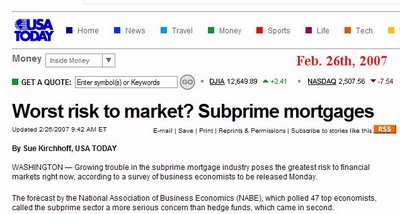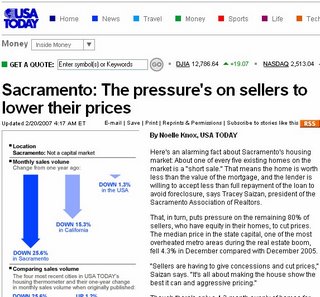
From Patric.net:
Q: What makes you a real estate bubble believer, a bubble debunker, or bubble neutral?
A: Owners and real estate businesses have a large vested interest in downplaying the bubble, no matter how real. Most renters are neutral, since they would probably rent anyway and don't really win or lose regardless of what happens to owners. But there is a small contingent of renters-by-choice who are adamant bubble believers and have made a big bet on it by renting. I'm one of them.
Q: How do you define a housing bubble?
A: Easy: when the monthly loss in interest, property tax, insurance and maintenance is larger than the monthly loss from renting, there is a housing bubble. Historically, it has been cheaper to own. That's how landlords can make a profit (duh). That's no longer the case in the San Francisco Bay Area. Since it's not only cheaper to rent now, but a whopping two to three times cheaper to rent the exact same thing than to own it, we clearly have the mother of all bubbles on our hands.
Q: How does this definition fit (or not fit) the national housing market? Which regional or local housing markets have exhibited the most bubble characteristics?
A: The national housing market does seem bubbly, but I don't know national average rents compared to owning. In the San Francisco Bay Area, where I live, it's clearly an extreme bubble. Other bubbly places now deflating are Boston, New York, Florida, Las Vegas, Los Angeles, and San Diego. Places with no bubble are generally those away from the coasts, where house-price inflation did not really take hold.
Q: Which bubbles burst? Which ones have deflated? Which ones are inflating? Which are about to pop?
A: I would say Boston has certainly burst now, but may continue to decline for years. New York, not so much yet. Florida is bursting, as are Las Vegas, Los Angeles and San Diego. The San Francisco Bay Area has declined only a little over the last year, but I think prices will continue downward for five years or more. Remember that prices fell for 14 years straight in Japan. So much for "real estate always goes up." I don't think there are any areas that are still inflating, especially now that there is a lot of attention in Washington focused on lending standards. The Bay Area is at very high risk for major declines. There was no reason for prices to double, so there is no reason they cannot fall right back down. Population actually declined, jobs went away, salaries went down and yet prices went up -- excellent illustration of a bubble.
Q: Are there any common traits among the bubble markets?
A: Yes, in general the bubble markets are more affluent and on the coasts. The feeling was that it must be safe to buy on the coasts because they are wealthier, but the reality is that buyers were not looking at very simple predictor ratios, like percentage of vacant houses, the ratio of salaries to house prices, the fraction of ARM (adjustable-rate mortgage) loans that are about to adjust dramatically upward and so on. Even though the populations in these areas should know better, they are running purely on gut feeling and not on the numbers. The numbers are now overpowering gut feeling. Foreclosures are rising exponentially.
Q: What is your best evidence for or against a housing bubble?
A: I can rent a million-dollar house for a little over 2 percent per year, but I cannot borrow $1 million in cash for 2 percent. It would cost more like 6 percent to rent (i.e., borrow) $1 million in cash. This proves that buyers are overpaying for houses by about a factor of three in the Bay Area. And this does not even consider the property taxes, insurance, maintenance and broker fees.
Q: Is it possible to accurately identify the existence of a bubble before it is gone? Explain.
A: Of course. When prices are extremely high by every measure ever used, it's a bubble. Price to salary ratio, price taking inflation into account, price compared to renting, etc., (are) all very high.
Q: How are bubbles born and how do they die?
A: Low interest rates have a nonlinear effect. That is, when interest rates go down from 5 percent to 4 percent, prices increase 20 percent (one-fifth). When rates go down from 4 percent to 3 percent, prices increase 25 percent. When interest rates hit zero, anyone can borrow an infinite amount of money. Once these crazy loans affect the market prices, the bubble takes on momentum and prices rise for a while just because everyone expects them to keep rising. And then interest rates go up and it all runs in reverse.
Q: Why do people get so fired up about the concept of a housing bubble?
A: There is huge psychological tension around the massive amounts of money involved. Buyers want to believe they did the right thing and will believe it no matter what the numbers in front of their eyes are. Renters-by-choice also want to believe they did the right thing, but most renters don't give a hoot about the whole affair.
From: www.Patrick.net





